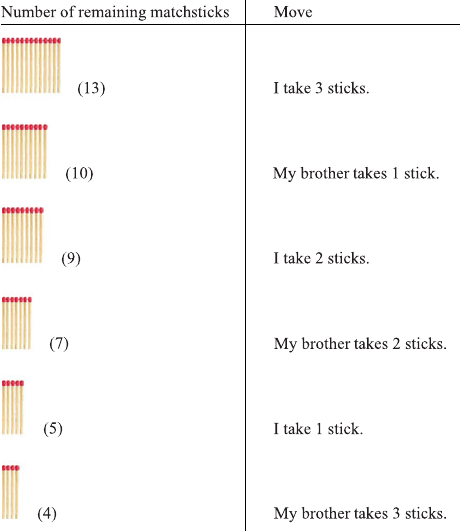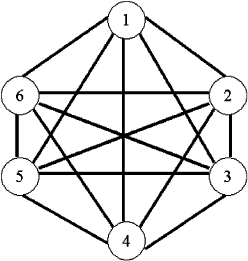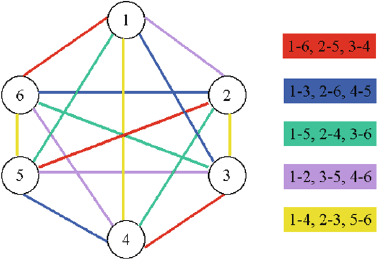Vocking B., Alt H., Dietzfelbinger M., Reischuk R., Scheideler C., Vollmer H., Wagner D. Algorithms Unplugged
Подождите немного. Документ загружается.


260 Jochen K¨onemann
13 matchsticks on the table. The table below summarizes the current game
situation. The left column shows the number of remaining sticks, and the right
column has the subsequent move.
After my brother’s last move, there is one last matchstick left on the table.
The rules of the game now force me to remove this stick from the table, and
I have then lost! “Well, that was clearly just luck!” I say, and ask for a revenge
game. Unfortunately, my brother wins this game and the following two as well,
and I am starting to get a little frustrated. My brother seems to have an edge
in this game. But how does he do that?
Learning from Small Examples
In order to better understand the game, I consider a few small examples.
I know that I lose the game if it is my turn and there is only a single match-
stick left on the table. But what should I do if there are exactly two sticks
on the table and it is my turn? Well, in this case, the solution is rather
straightforward: I should pick a single stick, which leaves my brother with one
remaining stick, and he has therefore lost the game. This says that I have a
winning strategy whenever two matchsticks remain, and it is my turn in the

26 Winning Strategies for a Matchstick Game 261
game. Given the above argument, it is not difficult to see that I also have a
winning strategy if it is my turn and there are 3 or 4 matchsticks on the table.
In the former case, I remove 2 sticks, and in the latter case, I pick 3. In both
cases, my brother is faced with a single stick lying in front of him, and he will
therefore lose the game.
Let us summarize the insights we gained so far. We now know that a player
has a winning strategy if it is his turn, and if there are 2, 3 or 4 matchsticks
remaining on the table. In either one of these cases, the player can move
strategically, and force the other player to lose the game.
The table below has a column for each of the game situations that we have
analyzed so far. The lower entry in column i (which we denote by GS
i
) indi-
cates whether the current player has a winning strategy, given that i match-
sticks remain.
i 12 3 4
GS
i
No Yes Yes Yes
So far so good. But what happens if there are 5 matchsticks on the table?
The answer to this question appears to be slightly less obvious in comparison
to the previous cases. It is, however, a game situation that interests me quite
a bit as it was the second to last configuration I faced in the first game
against my brother. Could I have forced him to lose out of this configuration?
Let’s see! The rules of the game force me to remove at least 1 and at most
3 matchsticks from the table. No matter what I do, my brother will have 2, 3
or 4 matchsticks left on the table. But we already know that he has a winning
strategy in each of these situations! Therefore, if my brother plays smartly,
he will force me to lose no matter how I move. As long as the other player
moves strategically, a player cannot win starting from a game configuration
with 5 matchsticks, and thus GS
5
=No.
If there are 6 matchsticks remaining on the table, I can take either 1, 2 or
3 sticks which leaves my brother with 3, 4 or 5 sticks. Looking at the table,
I know that my brother has a winning strategy, given that there are 3 or 4
sticks remaining for his move. However, if I leave him 5 sticks, then he can’t
win given that I play cleverly. Therefore, I do have a winning strategy, given
that there are 6 sticks remaining: I just have to take one stick off the table.
Therefore, we have GS
6
=Yes.
An Algorithm to Compute a Winning Strategy
It is now easy to extend the example calculations above. For example, assume
that we have already computed GS
i
for 1 ≤ i ≤ 14, and that we know whether
a player has a winning strategy, given that there are i matchsticks remaining,
whenever i is at most 14. If there are 15 matchsticks remaining, then the
current player needs to pick 1, 2 or 3 sticks off the table, and would leave 12,

262 Jochen K¨onemann
13 or 14 sticks for the next player. If the other player has a winning strategy
in each of these situations (i.e., GS
12
=GS
13
=GS
14
= Yes), and if he moves
cleverly, then the current player will lose the game; hence, we let GS
15
=No
in this case. If, however, if GS
j
= No for at least one j ∈{12, 13, 14}, then the
current player can force the other player to lose by picking 15 −j matchsticks,
and hence GS
15
=Yes.
We obtain the following algorithm to compute GS
1
to GS
x
:
WinningStrategy(x)
1GS
1
= No, GS
2
=Yes,GS
3
=Yes
2 i := 3
3 while i<xdo
4 i := i +1
5 if GS
i−3
=GS
i−2
=GS
i−1
=Yesthen
6GS
i
=No
7 else
8GS
i
=Yes
9 endif
10 endwhile
We can now use this algorithm to compute GS
1
to GS
18
. We summarize
the results of this run in the following table. For brevity, we use “N” for “No”
and “Y” for “Yes”.
i 123456789101112131415161718
GS
i
NYYYNYYYNY Y YNYYYNY
Wonderful! Now I know that my brother has a winning strategy whenever
he starts the game, and 18 matchsticks remain. But how exactly does he figure
out what number of matchsticks he needs to remove in each move?
Let us recall the first game between me and my brother. In this game, we
start with 18 matchsticks, and my brother has the first move. Looking at the
table, we see that GS
18
= Y, and he therefore has a winning strategy. He can
therefore win against me, as long as he makes the right moves. In his first
move, he will have to take 1, 2 or 3 matchsticks off the table. What should
he do? Another look at the table tells us that I have a winning strategy if my
brother leaves me 15 matchsticks. My brother will naturally want to avoid
this, and probably won’t remove three matchsticks. Similarly, he won’t take
2 matchsticks which would leave me with 16 sticks, and the table tells us that
I can win the game from this situation. The sole remaining option for my
brother is to remove 1 matchstick, and that will leave me 17 matchsticks for
my move. According to the table (GS
17
= N ), I will lose the game from here
if my brother makes no mistake.
“What was it that I did, after my brother removed 1 matchstick in his first
move?” Right! I picked up 2 of the remaining 17 matchsticks, leaving 15 for
my brother. The table tells us that my brother still has a winning strategy,
26 Winning Strategies for a Matchstick Game 263
starting from a configuration with 15 sticks. Furthermore, removing 2 is the
only option for him to maintain his advantage; i.e., GS
12
=GS
14
=Y,and
GS
13
= N. “So, after all this ‘game’ was a set-up and not an IQ-test! My
brother knew exactly what to do in order to make me lose!”
The Running Time of the Algorithm
How many elementary operations (comparisons and assignments) does the
algorithm need in order to compute GS
x
? The inner while-loop is executed
x −3 times. Every iteration in turn accesses three previously computed terms
GS
i−3
,GS
i−2
and GS
i−1
, in order to compute GS
i
. Therefore, three compar-
isons and two assignments suffice for steps 4–9 of the algorithm, and the total
number of steps needed is
(x − 3) · (3 + 2) + 4 = 5x − 11.
The running time is therefore proportional to the given number of matchsticks.
This is probably not a problem if we play the game in practice with the
matchsticks in front of us on the table. Naturally, we could use a computer to
execute our algorithm, and that would enable us to compute GS
x
for much
larger numbers x. For example, we could use a computer to determine who
wins starting from x = 9876543210 matchsticks. Even though this number can
be described with 10 digits, the algorithm would need roughly 5 ·9876543210
steps to find an answer; this is already quite a large number!
It would be a lot nicer if the number of steps in our algorithm were propor-
tional to the number of digits needed to write x, instead of being proportional
to the number itself. The number of digits needed to write x depends on the
representation used. Computers typically store numbers in so-called binary
representation, in which x corresponds to a string
a
k
a
k−1
...a
0
of 0, 1-bits such that
x =
k
i=0
2
i
a
i
.
The length of the input for our algorithm is then the length k + 1 of the
representation of x, and not the value of x.Howlargeisx with respect to its
representation length k? We clearly have
2
log
2
x+1
≥ 2
log
2
x+1
=2·x, (26.1)
and we therefore conclude that a
i
=0foralli>log
2
x. In other words, the
binary representation of x has at most log
2
x + 1 bits. The largest number
x that can be represented using k +1bitsis
264 Jochen K¨onemann
k
i=0
2
i
=2
0
+2
1
+ ···+2
k
.
This is a geometric series, and one can show that its value is exactly 2
k+1
−1
(we provide a reference to an article with further information below). Substi-
tuting k = log
2
x−1weobtain
log
2
x−1
i=0
2
i
=2
log
2
x
− 1 ≤ 2
log
2
x
− 1=x − 1, (26.2)
and the binary representation of x therefore needs at least log
2
x +1 bits.
The two bounds in (26.1)and(26.2) together imply that the length of the
binary representation of x is in the interval [log
2
x +1, log
2
x +1].The
number of operations needed by our algorithm is therefore
5x − 11 ≥ 5 · 2
k
− 11,
and this is exponential in the length k of the input x. Generally speaking,
we call an algorithm efficient if its running time is bounded by a polynomial
of the length of its input. Algorithms whose running time is bounded by a
polynomial of actual values in the input (like the algorithm in our example)
are called pseudo-polynomial time algorithms.
By the above reasoning, the algorithm WinningStrategy from our ex-
ample is therefore not a truly efficient algorithm; it is a pseudo-polynomial
time algorithm. It seems unlikely that my brother used it to compute his win-
ning strategy in the game against me. Indeed, my brother tells me that it is
easy to prove that we have GS
x
= Y whenever the remainder of x divided
by 4 is 1. Thus, once I have reached a configuration in which I have a win-
ning strategy, I can determine my move easily: whenever my opponent picks
y matchsticks, I will need to pick 4 − y sticks so that the sum of the sticks
taken by him and by me is always exactly 4.
It is easy to check that this formula is correct for the game played between
me and my brother, and that it explains why my brother did not need a table
or a computer to figure out his moves in his play against me.
Extensions and Background
The matchstick game we discussed in this chapter has numerous extensions.
One popular variant is called Nim and works as follows: the game starts with
several rows of matchsticks. Much like our game, Nim is once again a two-
player game. The two players move in turns. The moving player first picks
one of the remaining rows of matchsticks, and then takes at least one and
arbitrarily many of the remaining sticks in this row. Just like before, the
player who picks the last matchstick loses. The analysis of this game is very

26 Winning Strategies for a Matchstick Game 265
similar to the analysis presented before for the simpler (single-row) version.
In particular, there is also a formula describing the winning strategy for this
game.
The game Nim is quite old, and is generally believed to have its origins
in China (it is quite similar to the Chinese game Tsyanshidzi). The game
appeared first in Europe during the 16th century. Its name Nim was coined
by Charles Bouton, who published a complete analysis of Nim in 1901.
The algorithm WinningStrategy presented here is a relatively sim-
ple example of a method which is commonly known as dynamic program-
ming. This powerful method was developed during the 1940s by the Amer-
ican Richard Bellman, and is mostly used for the solution of more general
optimization problems whose instances can be decomposed into similar but
smaller subproblems. For example, in our matchstick game, we showed that
the question of whether a player has a winning strategy facing x remaining
matchsticks can be reduced to the same question with x − 1, x − 2andx −3
remaining sticks.
A far more complex example for dynamic programming is given in Chap. 31,
where the method is used to compute the mutation distance of two genetic
strings.
Further Reading
1. http://en.wikipedia.org/wiki/Nim
An article discussing the game Nim.
2. http://en.wikipedia.org/wiki/Dynamic
programming
Dynamic programming on Wikipedia.
3. http://en.wikipedia.org/wiki/Geometric
series
An article discussing geometric series.
4. D.P. Bertsekas: Dynamic Programming and Optimal Control,Vols.1
and 2. Athena Scientific, 3rd edition, 2005.
This comprehensive textbook provides in-depth coverage of dynamic pro-
gramming.

27
Scheduling of Tournaments or Sports Leagues
Sigrid Knust
Universit¨at Osnabr¨uck, Osnabr¨uck, Germany
Let us consider a small table tennis club that wants to organize a tournament
for six players. Each player has to play against each other player exactly once,
and every player should play at most one match per evening. Since each of the
six players has to play against five other players, in total
6·5
2
= 15 matches
have to be scheduled (we must divide by 2 since the match i against j is
counted for player i as well as for player j). If every player plays exactly one
match each evening, we have three matches per evening, i.e., for all matches
in total
15
3
= 5 evenings are needed.
The players start their competition, and every evening each player searches
for another player against whom he has not played before. After three evenings
the following matches have been performed:
Evening 1 Evening 2 Evening 3
1-2 1-3 1-4
3-5 2-6 2-5
4-6 4-5 3-6
It is easy to see that the remaining 6 matches, 1-5, 1-6, 5-6, 2-3, 2-4, 3-4,
cannot be completed within two additional evenings (when the match 1-5
takes place, the two matches 1-6 and 5-6 cannot be scheduled in parallel since
each player may only play one match per evening). Thus, the tournament can
only be finished during three additional evenings:
Evening 4 Evening 5 Evening 6
1-5 1-6 5-6
2-3 2-4 3-4
Hence, the club needs one more evening for the whole tournament than
originally intended. Furthermore, during the last two evenings two players do
not play.
B. V¨ocking et al. (eds.), Algorithms Unplugged,
DOI 10.1007/978-3-642-15328-0
27,
c
Springer-Verlag Berlin Heidelberg 2011

268 Sigrid Knust
Somebody who is interested in sports may notice that similar scheduling
problems occur for several sports leagues. For example, in the German soccer
league 18 teams play a tournament with 2 half-series, where in each half-
series every team plays against every other team exactly once. Usually, in
every round (weekend) within 2 ·17 = 34 weeks every team plays exactly one
match. Thus, we may ask the question whether, for any number of teams, a
schedule always exists in which all teams play in every round.
Let us now consider this scheduling problem from a more general point
of view: Given are an even number n of teams (or players) and n − 1 rounds
(days for matches). The objective is to determine a schedule such that each
team plays against each other team exactly once, and each team plays exactly
one match per round. Thus, for each even number n, we ask whether such
a schedule exists and how we can construct a corresponding schedule. In the
following we show that for each even n a solution exists (i.e., for n =18as
well as for n = 6, but also for n = 100 or n = 1024). Furthermore, we describe
an algorithm which constructs such a schedule for any even number n.
Generation of Schedules
In order to describe an algorithm for the generation of schedules we first model
our problem using so-called graphs, which are often used in computer science
(see also Chaps. 28, 32, 33, 34,and40). A graph consists of a set of vertices
and a set of edges, where an edge connects two vertices. For example, with a
graph we may model a network of roads where the roads correspond to the
edges and the crossings correspond to the vertices.
For our sports scheduling problem we introduce a vertex for each team;
the matches correspond to the edges. For example, for n = 6 teams we obtain
the graph in Fig. 27.1.
Fig. 27.1. Graph for six teams

27 Scheduling of Tournaments or Sports Leagues 269
Such a graph is also called complete since each vertex is connected with
every other vertex by an edge (recall that each team plays against every
other team). In order to obtain a schedule we color the edges with the colors
1, 2,...,n−1, where every color represents a round. Such a coloring is called
feasible if it corresponds to a feasible schedule. This is the case if all edges that
are connected to the same vertex are colored with different colors (otherwise
not every team plays once per round).
For our graph with n = 6 vertices, the edge coloring in Fig. 27.2 with
n − 1 = 5 colors is feasible. A corresponding schedule is shown beside the
graph, where the color “red” represents the first round, the color “blue” the
second round, etc.
It remains to show how a feasible edge coloring of the complete graph for
any even number n can be constructed. In our example let us consider the
graph which is obtained after eliminating vertex 6 and all 5 edges that are
connected to this vertex. We get a pentagon where the 5 edges on the boundary
(1-2, 2-3, 3-4, 4-5, 5-1) are colored differently. If we draw this pentagon as a
regular pentagon as in Fig. 27.3 (i.e., all angles at the 5 corners are equal),
we see that each edge in the inner part of the pentagon is colored with the
same color as the corresponding parallel edge on the boundary. If in an edge
coloring always only parallel edges (which are not connected to the same
vertex) are colored with the same color, obviously the condition is fulfilled
that edges which are connected to the same vertex are colored differently. In
our example we also see that for each of the five vertices four colors are used
and always one other color is missing (which can be used for the edges to
vertex 6).
These considerations can be used to construct a feasible edge coloring of
any complete graph having an even number n of vertices. The origin of this
procedure is not precisely known, but it is reported that the English pastor
and mathematician Thomas P. Kirkman (1806–1895) did similar considera-
tions. Please see the algorithm “Edge Coloring” which iteratively colors sets
Fig. 27.2. Edge coloring of the graph with six teams
